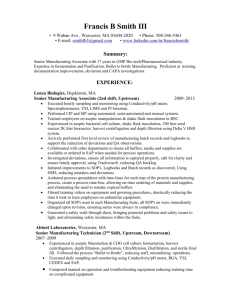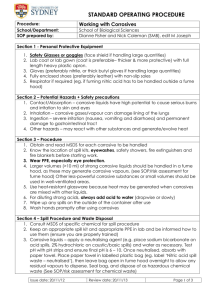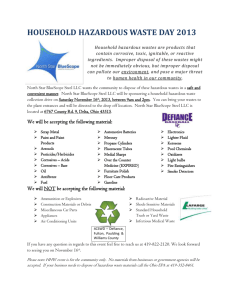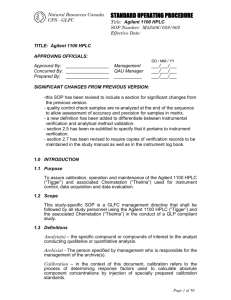Protein purification
advertisement
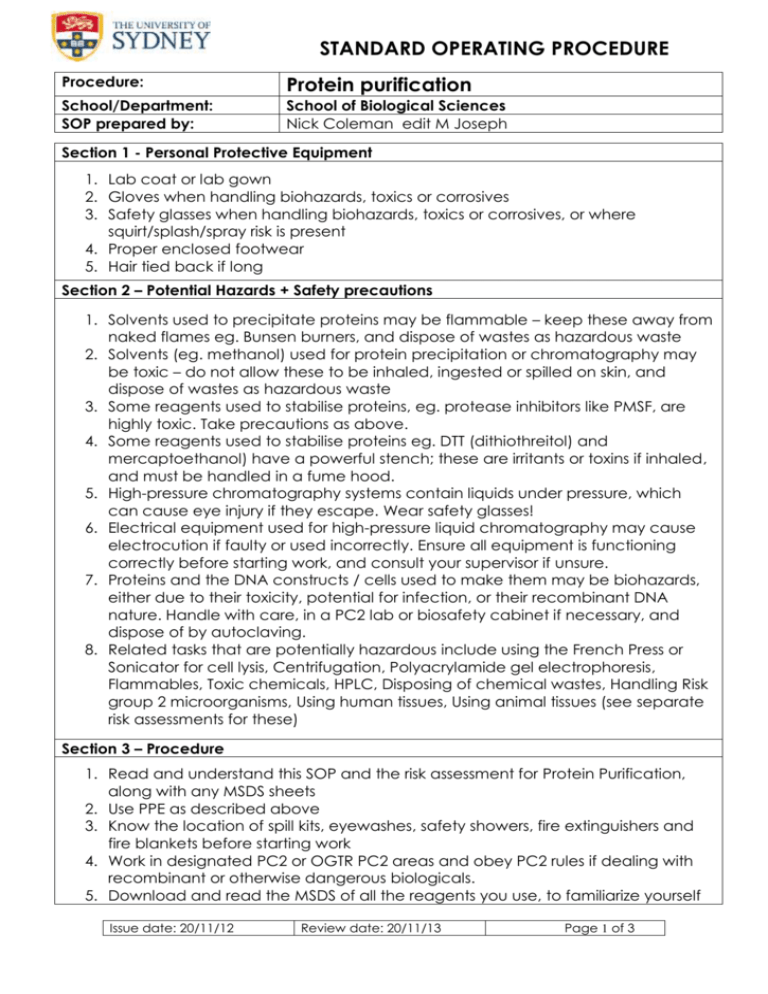
STANDARD OPERATING PROCEDURE Procedure: Protein purification School/Department: SOP prepared by: School of Biological Sciences Nick Coleman edit M Joseph Section 1 - Personal Protective Equipment 1. Lab coat or lab gown 2. Gloves when handling biohazards, toxics or corrosives 3. Safety glasses when handling biohazards, toxics or corrosives, or where squirt/splash/spray risk is present 4. Proper enclosed footwear 5. Hair tied back if long Section 2 – Potential Hazards + Safety precautions 1. Solvents used to precipitate proteins may be flammable – keep these away from naked flames eg. Bunsen burners, and dispose of wastes as hazardous waste 2. Solvents (eg. methanol) used for protein precipitation or chromatography may be toxic – do not allow these to be inhaled, ingested or spilled on skin, and dispose of wastes as hazardous waste 3. Some reagents used to stabilise proteins, eg. protease inhibitors like PMSF, are highly toxic. Take precautions as above. 4. Some reagents used to stabilise proteins eg. DTT (dithiothreitol) and mercaptoethanol) have a powerful stench; these are irritants or toxins if inhaled, and must be handled in a fume hood. 5. High-pressure chromatography systems contain liquids under pressure, which can cause eye injury if they escape. Wear safety glasses! 6. Electrical equipment used for high-pressure liquid chromatography may cause electrocution if faulty or used incorrectly. Ensure all equipment is functioning correctly before starting work, and consult your supervisor if unsure. 7. Proteins and the DNA constructs / cells used to make them may be biohazards, either due to their toxicity, potential for infection, or their recombinant DNA nature. Handle with care, in a PC2 lab or biosafety cabinet if necessary, and dispose of by autoclaving. 8. Related tasks that are potentially hazardous include using the French Press or Sonicator for cell lysis, Centrifugation, Polyacrylamide gel electrophoresis, Flammables, Toxic chemicals, HPLC, Disposing of chemical wastes, Handling Risk group 2 microorganisms, Using human tissues, Using animal tissues (see separate risk assessments for these) Section 3 – Procedure 1. Read and understand this SOP and the risk assessment for Protein Purification, along with any MSDS sheets 2. Use PPE as described above 3. Know the location of spill kits, eyewashes, safety showers, fire extinguishers and fire blankets before starting work 4. Work in designated PC2 or OGTR PC2 areas and obey PC2 rules if dealing with recombinant or otherwise dangerous biologicals. 5. Download and read the MSDS of all the reagents you use, to familiarize yourself Issue date: 20/11/12 Review date: 20/11/13 Page 1 of 3 with the hazards. Keep the MSDS in a known location so it can be found easily. 6. If using acid or other corrosive agent to clean the protein purification column, wear safety glasses and beware of excessive pressure or poor-fitting junctions – these can cause acid to spray out. 7. Ensure equipment e.g. HPLC is kept in good working order via routine maintenance as part of service contract. Beware of electrical hazards with machines such as HPLC – get machine serviced immediately if there is any suspicion of electrical malfunction. 8. Dispose of waste solvents appropriately. Consult waste disposal officer if in doubt. 9. Don’t use flammable solvents near ignition sources, especially naked flames. It is recommended that a 3 m gap exists between solvent use/storage areas and possible ignition sources (these include fridges and freezers and other machines with exposed electricals) 10. Use reagents that make flammable or very smelly vapours (e.g. mercaptoethanol) in the fume hood. 11. Know the risks of all machinery you use. E.g. the equipment used for cell lysis (sonicator, French press) is potentially hazardous – obtain and read the risk assessments for these pieces of equipment or do the risk assessments yourself. 12. Many diverse procedures are required for protein purification, and no single SOP can cover them all. Read any specific instruction manuals and consult any equipment or room custodians before starting work. If you have any concerns or uncertainties, talk to your supervisor Section 4 – Disposal / Spills / Incidents 1. Depending on the nature of the spill, clean up as described in SOPs for Biohazard Spills, Flammables, Corrosives, or Toxic Substances. 2. Depending on the nature of the materials used, dispose of wastes as described in SOPs for Biohazard Spills, or Chemical Wastes 3. Any large spills of hazardous materials (>1L) or incidents resulting in injury must be reported to your supervisor immediately and via the online incident report form within 24 h. Near misses (dangerous situations not leading to an incident) should also be reported Section 5 – Repairs / Certification / Validation 1. Ensure any equipment used is kept in good repair. Consult the manufacturer if in doubt Section 6 – Relevant Material safety data sheets 1. Due to the diversity of protein purification methods, many different MSDS may be appropriate. E.g. methanol, acetonitrile, butanol, mercaptoethanol, PMSF. Make sure you know the identity and risks of the chemicals you are using and have read and understood the appropriate MSDS Section 7 - References 1. 2. Essential: Risk assessment for Protein Purification As needed: Risk assessment and SOP for French Press , Sonicator, Centrifugation, Polyacrylamide gel electrophoresis, Flammables, Toxic chemicals, HPLC, Disposing of chemical wastes, Handling Risk group 2 Issue date: 20/11/12 Review date: 20/11/13 Page 2 of 3 microorganisms, Using human tissues, Using animal tissues SOP Training Confirmation By signing below, these individuals confirm that they have read and understood the SOP, and agree to always follow the instructions in this SOP when performing this procedure. Position Name Signature Date Supervisor employee / student employee / student employee / student employee / student employee / student employee / student employee / student employee / student employee / student employee / student employee / student employee / student employee / student employee / student employee / student employee / student employee / student employee / student employee / student employee / student employee / student employee / student employee / student employee / student WHS Committee Approval Representative: A. Prof Frank Seebacher Chair Safety Committee Signature: ........................................................ Date: ..................................... Issue date: 20/11/12 Review date: 20/11/13 Page 3 of 3
